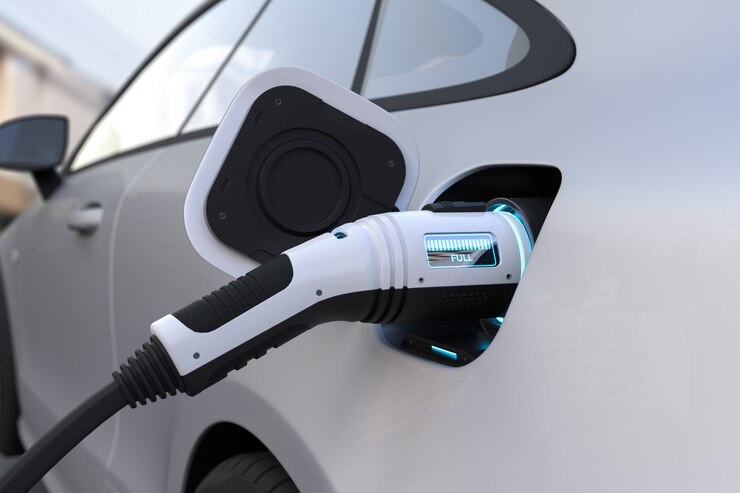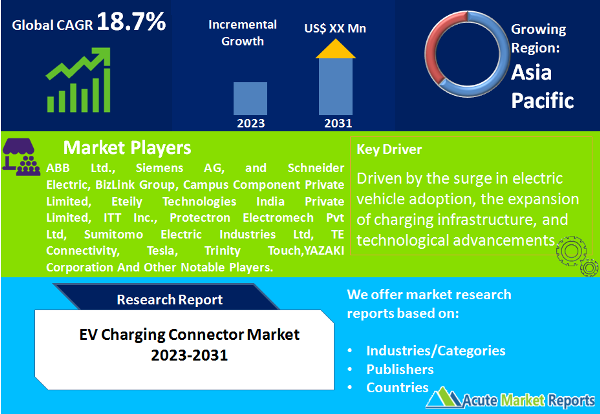
The electric vehicle (EV) charging connector market is expected to grow at a CAGR of 18.7% during the forecast period of 2025 to 2033, due to the surge in electric vehicle adoption globally. EV charging connectors are essential components for charging electric vehicles, and their demand is closely tied to the expansion of the electric vehicle infrastructure. In conclusion, the EV Charging Connector market is expected to experience robust growth from 2025 to 2033, driven by the surge in electric vehicle adoption, the expansion of charging infrastructure, and technological advancements. However, infrastructure challenges may hinder the market's progress. The market is segmented by charging type and level type, with varying revenue and CAGR trends. Geographic trends indicate strong growth in North America and Europe, and key players are poised to maintain their competitive positions through strategic initiatives.

Rapid Growth in Electric Vehicle Adoption
The primary driver of the EV Charging Connector market is the rapid growth in electric vehicle adoption. With increasing environmental concerns and government incentives to reduce greenhouse gas emissions, consumers and businesses are shifting towards electric vehicles. This trend is particularly evident in regions like Europe and China. For instance, in 2024, Europe witnessed a remarkable increase in electric vehicle sales, with countries like Norway reporting over 70% of new car registrations being electric. This surge in electric vehicle adoption is expected to continue throughout the forecast period from 2025 to 2033, driving the demand for EV charging connectors.
Expansion of Charging Infrastructure
The expansion of EV charging infrastructure is another crucial driver of the market. Governments and private organizations worldwide are investing heavily in building charging stations to support the growing number of electric vehicles on the road. For example, the United States announced plans to deploy 500,000 charging stations by 2033 as part of its efforts to promote clean transportation. As charging infrastructure becomes more widespread and accessible, the demand for charging connectors, especially Type 2 connectors for home and public charging, is expected to surge.
Technological Advancements and Compatibility
Technological advancements in EV charging connectors have played a pivotal role in market growth. Manufacturers have been developing connectors that are faster, more efficient, and compatible with a wide range of electric vehicles. Interoperability between different EV models and charging stations has become a key focus, with the aim of providing a seamless charging experience. This has led to the development of universal connectors like the CCS (Combined Charging System) and CHAdeMO, which can handle both AC and DC charging. These advancements are anticipated to continue, fostering the adoption of EVs and driving the demand for advanced charging connectors.
Infrastructure Challenges
While the expansion of EV charging infrastructure is a driver, it also presents a significant restraint. Building a comprehensive charging network requires substantial investment and coordination among various stakeholders, including governments, utilities, and private companies. Delays in infrastructure development, including permitting, grid upgrades, and site acquisition, can hinder the widespread availability of charging stations. This, in turn, affects the demand for EV charging connectors. Additionally, challenges related to grid capacity and distribution can lead to bottlenecks and limit the scalability of charging infrastructure. Overcoming these infrastructure challenges will be essential to support the anticipated growth of the EV market and the corresponding demand for connectors during the forecast period.
Market by Type: Type 2 Dominates the Market
In 2024, Type 2 charging connectors generated the highest revenue due to their compatibility with a wide range of electric vehicles and their use in both residential and public charging stations. They are favored for their versatility and ability to handle AC and DC charging. However, from 2025 to 2033, Type 3 connectors are expected to exhibit the highest CAGR. This growth is driven by advancements in fast-charging technology, making them suitable for commercial and industrial applications. Type 3 connectors are especially important for businesses looking to provide rapid charging options, reducing downtime for electric vehicle fleets.
Market by Level: Level 2 Dominates the Market
Level 2 charging connectors accounted for the highest revenue in 2024, as they are commonly used for residential charging. They provide a balance between charging speed and convenience, making them suitable for overnight charging at home. However, during the forecast period from 2025 to 2033, Level 4 connectors are expected to experience the highest CAGR. Level 4 connectors are designed for ultra-fast charging, significantly reducing charging times, especially for long-distance travel. As electric vehicle manufacturers produce models capable of handling faster charging rates, Level 4 connectors will become increasingly essential for reducing "range anxiety" among consumers and enabling EVs for long journeys.
APAC Remains as the Global Leader
The Asia-Pacific region, particularly China, led in terms of revenue percentage in 2024, driven by its significant electric vehicle market. China, in particular, has witnessed impressive growth in EV sales, with domestic manufacturers contributing significantly. The region has invested heavily in charging infrastructure, focusing on building a vast network to support its growing electric vehicle fleet. However, from 2025 to 2033, the Asia-Pacific region is expected to exhibit moderate to high CAGR. As other countries in the region, such as India and South Korea, accelerate their electric vehicle adoption efforts, the demand for charging connectors is expected to grow substantially. In 2024, North America showed strong revenue generation in the EV Charging Connector market, driven by the growing electric vehicle market in the United States and Canada. The region has made substantial investments in charging infrastructure, with an emphasis on developing a reliable network to support long-distance travel and urban charging needs. From 2025 to 2033, North America is expected to exhibit the highest CAGR in the market. This growth is fuelled by government incentives, electric vehicle mandates, and efforts to create a seamless charging experience for consumers. Partnerships between automakers and charging network operators are expected to further boost the adoption of EVs and charging connectors in the region.
Market Competition to Intensify during the Forecast Period
Key players in the EV Charging Connector market include ABB Ltd., Siemens AG, and Schneider Electric, BizLink Group, Campus Component Private Limited, Eteily Technologies India Private Limited, ITT Inc., Protectron Electromech Pvt Ltd, Sumitomo Electric Industries Ltd, TE Connectivity, Tesla, Trinity Touch and YAZAKI Corporation. In 2024, these companies were among the top players in terms of revenue. During the forecast period from 2025 to 2033, these companies are expected to continue their leadership by implementing strategies such as product innovation, partnerships with electric vehicle manufacturers, and expanding their geographical presence to cater to the increasing demand for charging connectors.
Historical & Forecast Period
This study report represents analysis of each segment from 2023 to 2033 considering 2024 as the base year. Compounded Annual Growth Rate (CAGR) for each of the respective segments estimated for the forecast period of 2025 to 2033.
The current report comprises of quantitative market estimations for each micro market for every geographical region and qualitative market analysis such as micro and macro environment analysis, market trends, competitive intelligence, segment analysis, porters five force model, top winning strategies, top investment markets, emerging trends and technological analysis, case studies, strategic conclusions and recommendations and other key market insights.
Research Methodology
The complete research study was conducted in three phases, namely: secondary research, primary research, and expert panel review. key data point that enables the estimation of EV Charging Connector market are as follows:
Market forecast was performed through proprietary software that analyzes various qualitative and quantitative factors. Growth rate and CAGR were estimated through intensive secondary and primary research. Data triangulation across various data points provides accuracy across various analyzed market segments in the report. Application of both top down and bottom-up approach for validation of market estimation assures logical, methodical and mathematical consistency of the quantitative data.
| ATTRIBUTE | DETAILS |
|---|---|
| Research Period | 2023-2033 |
| Base Year | 2024 |
| Forecast Period | 2025-2033 |
| Historical Year | 2023 |
| Unit | USD Million |
| Segmentation | |
Charging Type
| |
Level Type
| |
Voltage Type
| |
Charging Speed Type
| |
|
Region Segment (2023-2033; US$ Million)
|
Key questions answered in this report